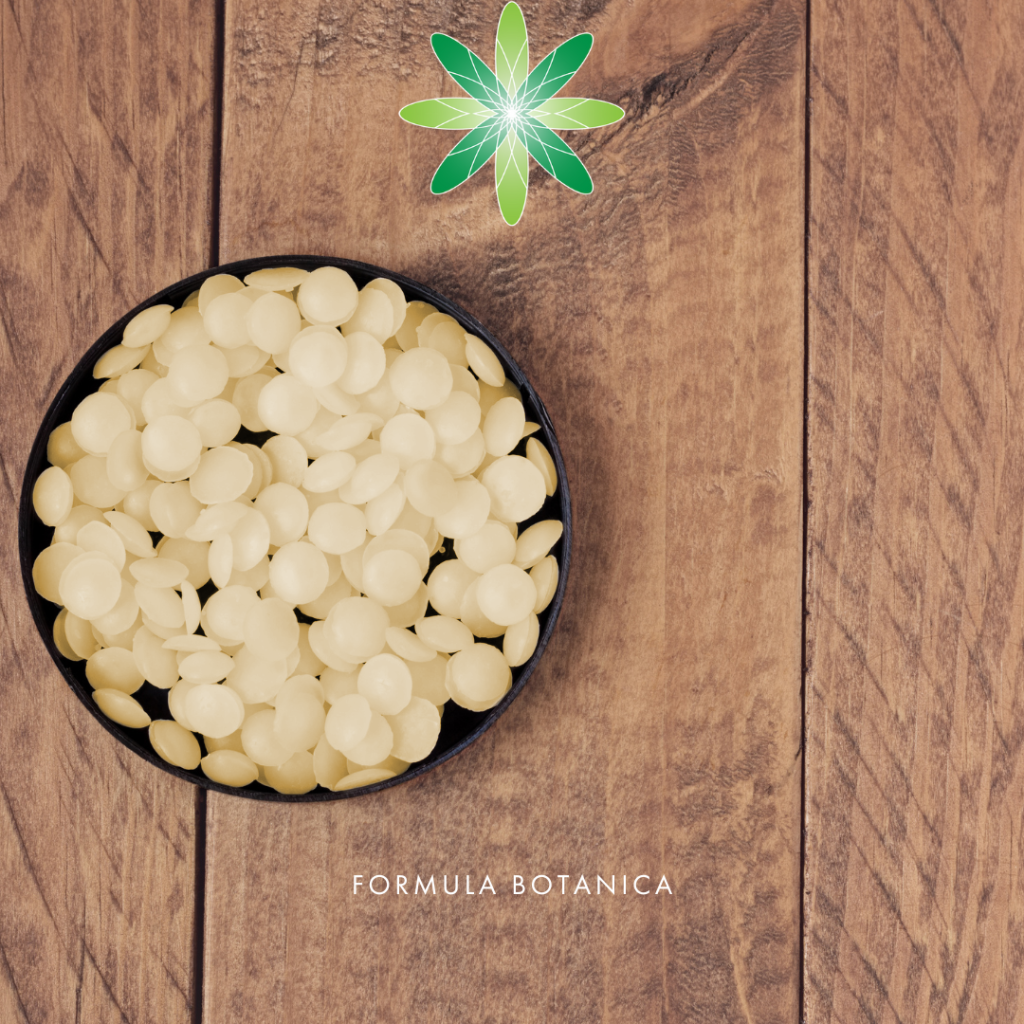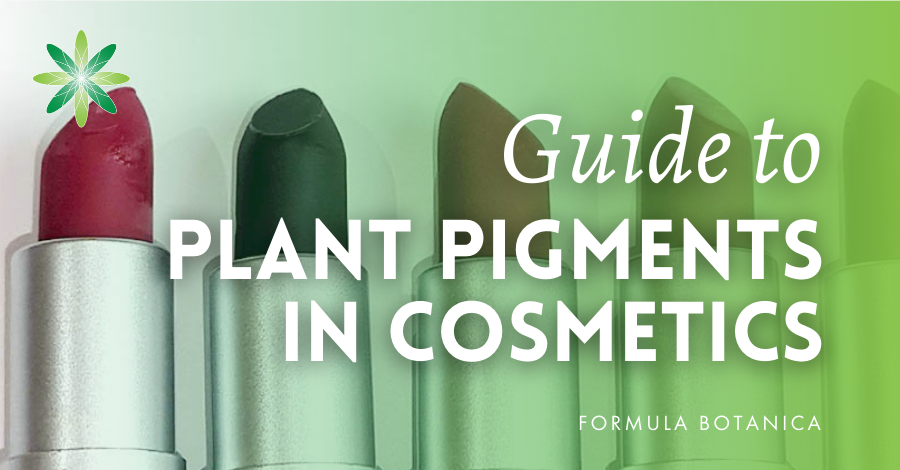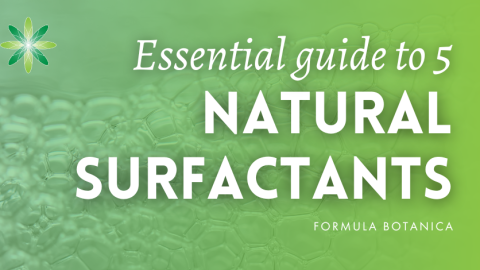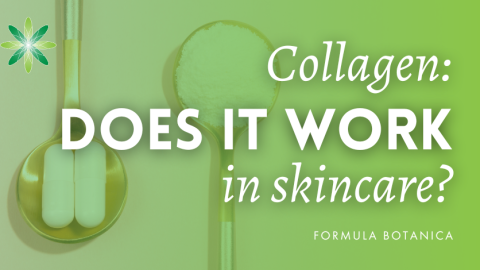Updated: 30.07.24
Are you passionate about creating organic cosmetic formulations? If so, you probably already know how essential waxes are for your products. Take beeswax. Beeswax is one of the oldest and most cherished ingredients in the beauty world and has been a staple in balms and potions for over 1,000 years. But what if you wanted to make vegan cosmetics and steer clear of beeswax? Well, you’re in luck!
In this blog post, we’ll unveil the best vegan waxes for organic homemade products. We’ll dive into their unique properties and see how vegan waxes stack up against traditional beeswax. Ready to get started? Let’s dive in!
Why Should You Formulate with Vegan Waxes?
With the booming demand for vegan cosmetics, many formulators are on the hunt for plant-based ingredients, including vegan waxes. Find out more about veganism below:
Vegan & cruelty free-cosmetics: what every natural formulator needs to know
How to formulate vegan organic cosmetics
What are real waxes?
Natural waxes are fascinating members of the lipid family. These waxes, composed of hydrocarbons and fatty esters, are derived from leaves, peels, fruits, and plant oils. The extraction process is purely physical, involving no chemical reactions. Once separated, these waxes are usually purified, deodorized, and sometimes bleached.
Waxes come in a range of grades according to their colour, melting point, and physical form. They are also often available in different purities for different applications, whether for industrial use, food products, cosmetics or pharmaceutical applications.
Since these ingredients are derived or extracted from a plant or plant oil, they are considered true waxes. Their true nature is confirmed by their INCI (International Nomenclature of Cosmetic Ingredients) names, which include “cera” or “wax.” For instance, Oryza Sativa Cera and Oryza Sativa Bran Wax refer to rice bran wax.
In this blog post, we’ll explore these genuine waxes in detail. But first, let’s clear up what doesn’t qualify as a real wax.
Pseudo-Waxes: Floral Waxes
any suppliers will sell certain ingredients as real vegan waxes, but the truth is that these are pseudo-waxes. A well-known example includes floral waxes. These floral waxes are probably the most confusing ingredients because the INCI name contains “cera”. See below for examples:
- Cananga odorata flower cera (ylang ylang flower wax)
- Jasminum grandiflorum flower cera (jasmine flower wax)
- Lavandula angustifolia flower cera (lavender flower wax)
- Rosa damascena flower cera (rose flower wax)
- Acacia decurrens flower cera (mimosa flower wax)
As a formulator, you will probably feel quite excited when you see these ingredient names. The concept of formulating with jasmine flower wax will be extremely appealing to many organic cosmetic formulators. But these ingredients are not true waxes. We call them pseudo-waxes.
These pseudo-waxes are usually very dark-coloured and extremely expensive. They are usually the by-products of the production of floral absolutes. After the first extraction is done, the remaining material is once more extracted with alcohol, which is then evaporated. The product that remains contains resins and some waxes and is sold as a floral wax.
Pseudo-Waxes: Hydrogenated Oils
Hydrogenated oils are sometimes also sold as plant-based and vegan waxes. However, these ingredients are not waxes at all. You can also see that they don’t contain the words “cera” or “wax” in their INCI name. Examples include:
• Hydrogenated hemp seed oil (hemp wax)
• Hydrogenated soybean oil (soy wax)
• Hydrogenated castor oil (castor wax)
• Hydrogenated olive oil (olive wax)
• Hydrogenated rapeseed oil (rapeseed wax)
• Hydrogenated avocado oil (avocado wax)
• Hydrogenated vegetable oil (vegetable wax)
Hydrogenation is a chemical reaction that occurs under the presence of a catalyst, reducing double carbon bonds to single bonds in vegetable oils. The goal is to increase the melting point of the oil (solidify the liquid oil) and to increase its shelf life. The oils are usually refined which means that they are stripped of their unsaponifiables (the good stuff in your oils!) before they undergo hydrogenation.
Pseudo-Waxes: Oil Blends & Hydrogenated Oils
It can become even more complicated when suppliers sell blends mixing plant oils with hydrogenated vegetable oil as plant-based or vegan waxes. Examples include:
• Cannabis sativa oil (and) hydrogenated vegetable oil (hemp wax)
• Prunus amygdalus dulcis oil (and) hydrogenated vegetable oil (almond wax)
It is even possible that one of your suppliers sells you a product labelled as rice bran wax, but when you have a closer look at the INCI name, you find that it is a blend of vegetable shortening and rice bran oil. This is why we always encourage you to check the full INCI name of the product to avoid any confusion and disappointment.
There is nothing wrong with using any of these pseudo-waxes in your products. However, you should be aware that these are very different products with different functions, compared to true waxes. These are hardened vegetable oils sold as precious vegan waxes – and it’s not always clear which vegetable oils have been used in the process.
You are free to use any of these pseudo-waxes in your products. However, we recommend that you always double-check the INCI name of the ingredient first, so you know exactly what you are working with.
Introducing Vegan Waxes
Now that you know which ingredients are not real waxes, let’s talk about real plant waxes for vegan cosmetics.
The most important properties of each wax are its melting point, acid value and saponification value. Sometimes, a wax’s iodine value is mentioned as well. You can find all that in your supplier’s safety data sheets (SDS). Colour varies from source to source and the method of extraction and purification. We’ll now run you through 6 vegan waxes that you can use in organic cosmetics:
Carnauba Wax
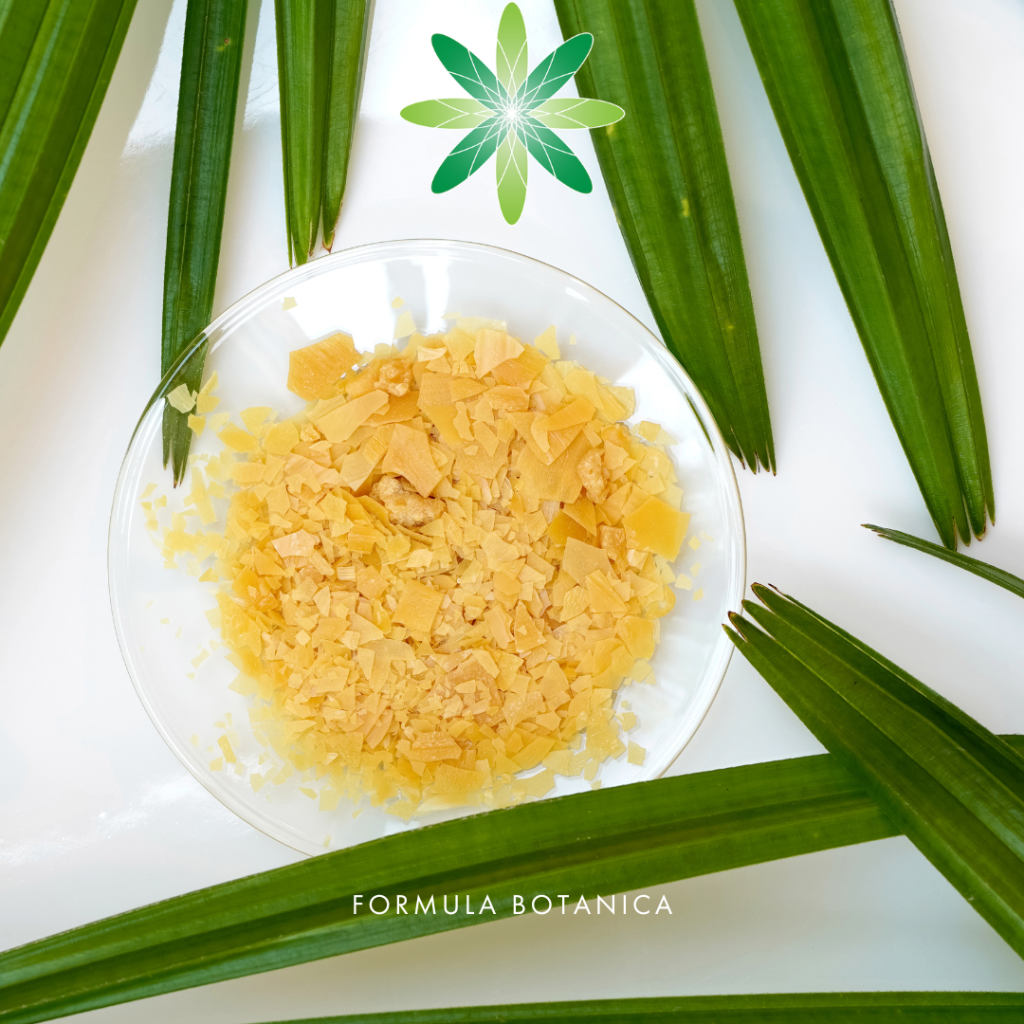
- INCI name: Copernicia cerifera cera or Copernicia cerifera wax
- Melting point: 80-86°C
- Saponification value: 78-95 mg KOH/g
- Acid value: 2-15 mg KOH/g
Carnauba wax imparts hardness and reduces stickiness in cosmetic formulations. It is applied in mascara as a volumising agent. In hair styling products, carnauba wax imparts hold. In water-in-oil emulsions, it is used as a stabiliser and a viscosity modifier.
Carnauba’s content of hydrocarbons is rather low (compare its saponification value and acid value with candelilla wax) and its main components are fatty esters.
Although the production of carnauba wax is generally sustainable, challenges such as deforestation for agricultural expansion, pest infestations, and socio-economic concerns regarding labour conditions pose significant threats to its sustainable cultivation.
Candelilla Wax
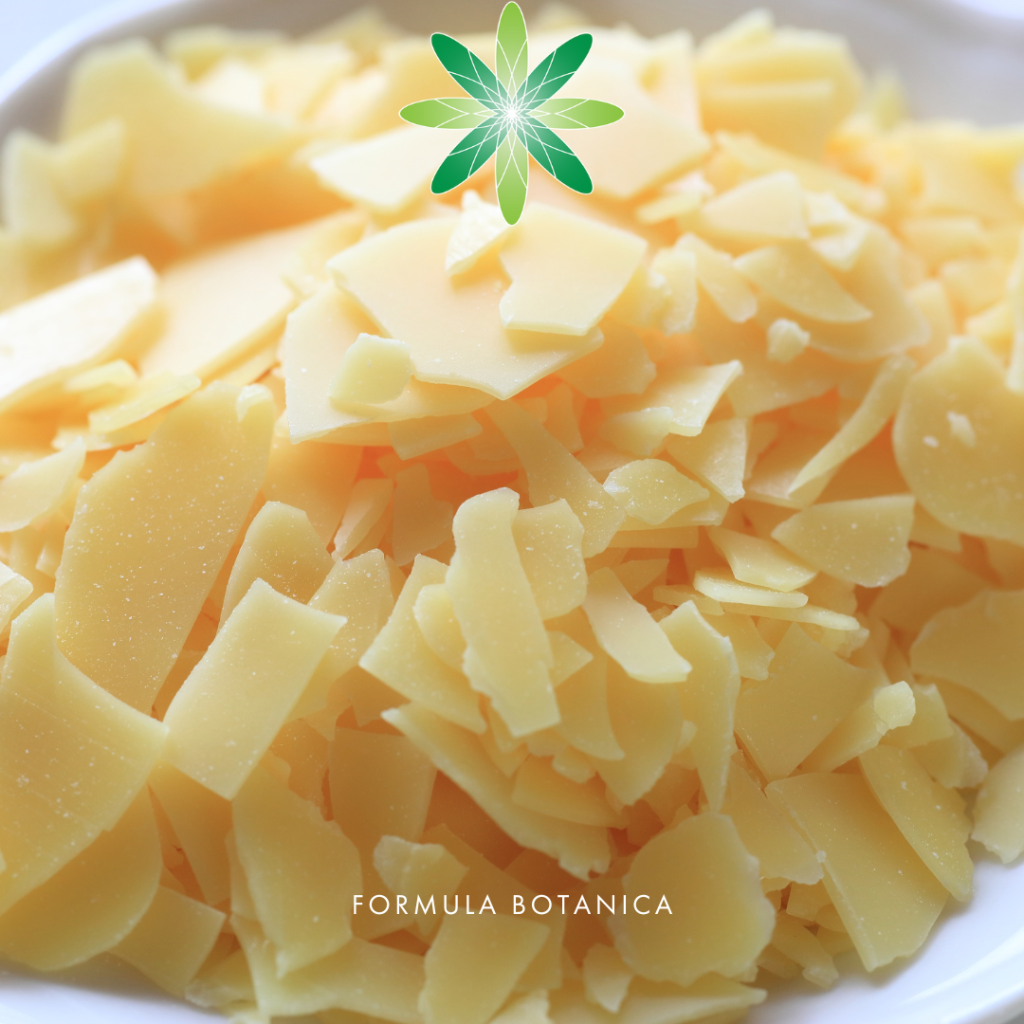
- INCI name: Euphorbia cerifera cera or Euphorbia cerifera wax
- Melting point: 68-73°C
- Saponification value: 43-65 mg KOH/gr
- Acid value: 12-22 mg KOH/gr
Candelilla wax has a high oil binding capacity and is less sticky than beeswax. It is used to adjust viscosity in water-in-oil emulsions. It imparts gloss and hardness in cosmetic products such as hair wax and lipstick. Candelilla contains up to 50% hydrocarbons and only 20-30% fatty esters.
Berry Wax
Berry wax is a soft wax with a light colour. It is extracted from the berries of Rhus verniciflua. The tree is called varnish tree or lacquer tree because the stem exudate is used in the production of Japanese lacquer.
- INCI name: Rhus verniciflua peel cera or Rhus verniciflua peel wax
- Melting point: 48-54°C
- Saponification value: 180-220 mg KOH/gr
- Acid value: 5-30 mg KOH/gr
Berry wax has a high ester content and consists mainly of esters of palmitic acid, stearic acid and a unique C21 fatty acid: heneicosylic acid. Because of its softness and low melting point, it is not suitable for stick formulations as a stand-alone wax. Its main applications are in pencil production or emulsion stabilisation as well as in balms.
Myrica Fruit Wax

- INCI name: Myrica cerifera fruit wax
- Melting point: 45-55ºC
- Saponification value: 210-240 mg KOH/gr
- Acid value: 5-25 mg KOH/gr
Myrica fruit wax imparts a very nice skin feel to balms, butters and hair styling products. It doesn’t contribute much to hardness and mainly adds texture body (without greasiness) and emulsion stabilisation to cosmetic products. Since it has a low melting point, it solidifies very slowly and this leads to a very nice and smooth texture of the products made with myrica wax. It is capable of making lip balms in a tube or even some stick products such as a facial balm but is not hard enough to be used as the stand-alone wax for lipsticks.
Rice Bran Wax
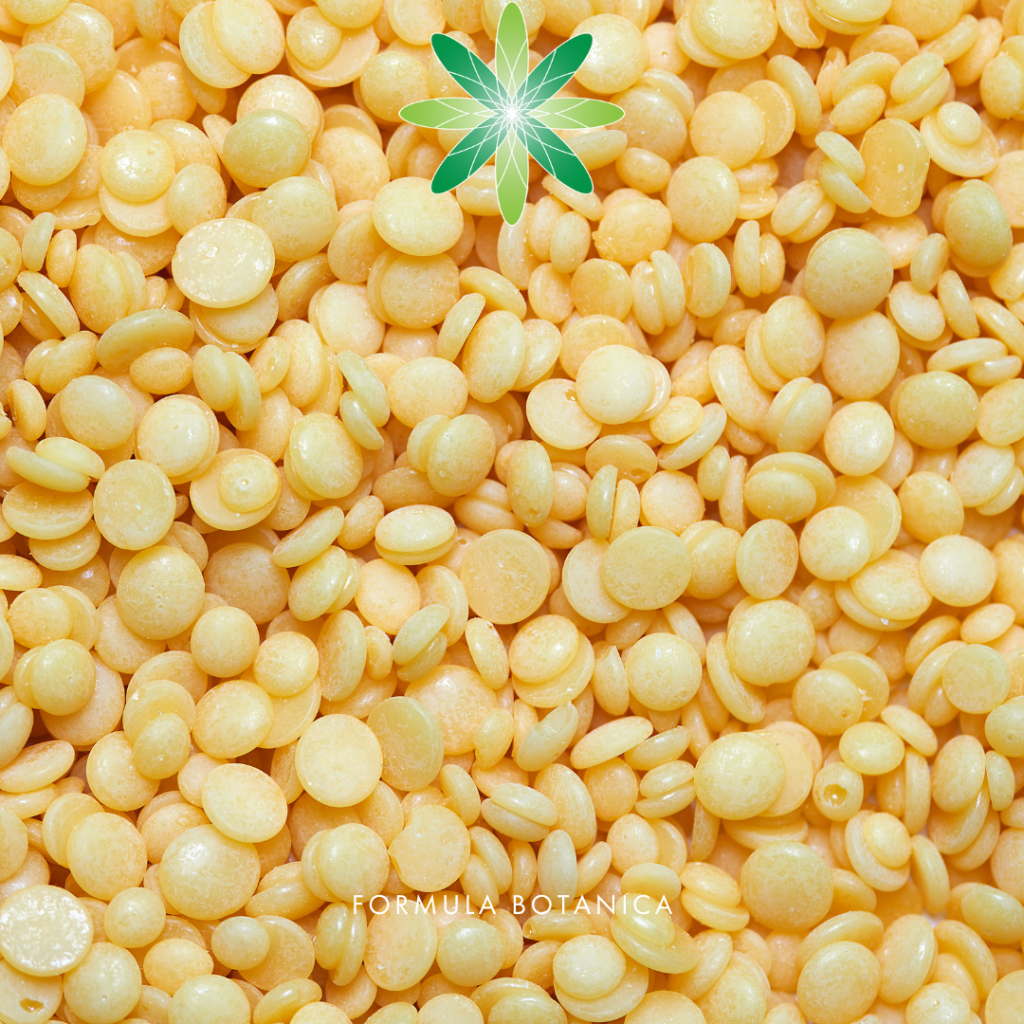
- INCI name: Oryza sativa cera or Oryza sativa bran cera or Oryza sativa bran cera or Oryza sativra bran wax
- Melting point: 79-85°C
- Saponification value: 65-95 mg KOH/gr
- Acid value: <15 mg KOH/gr
Sunflower Wax
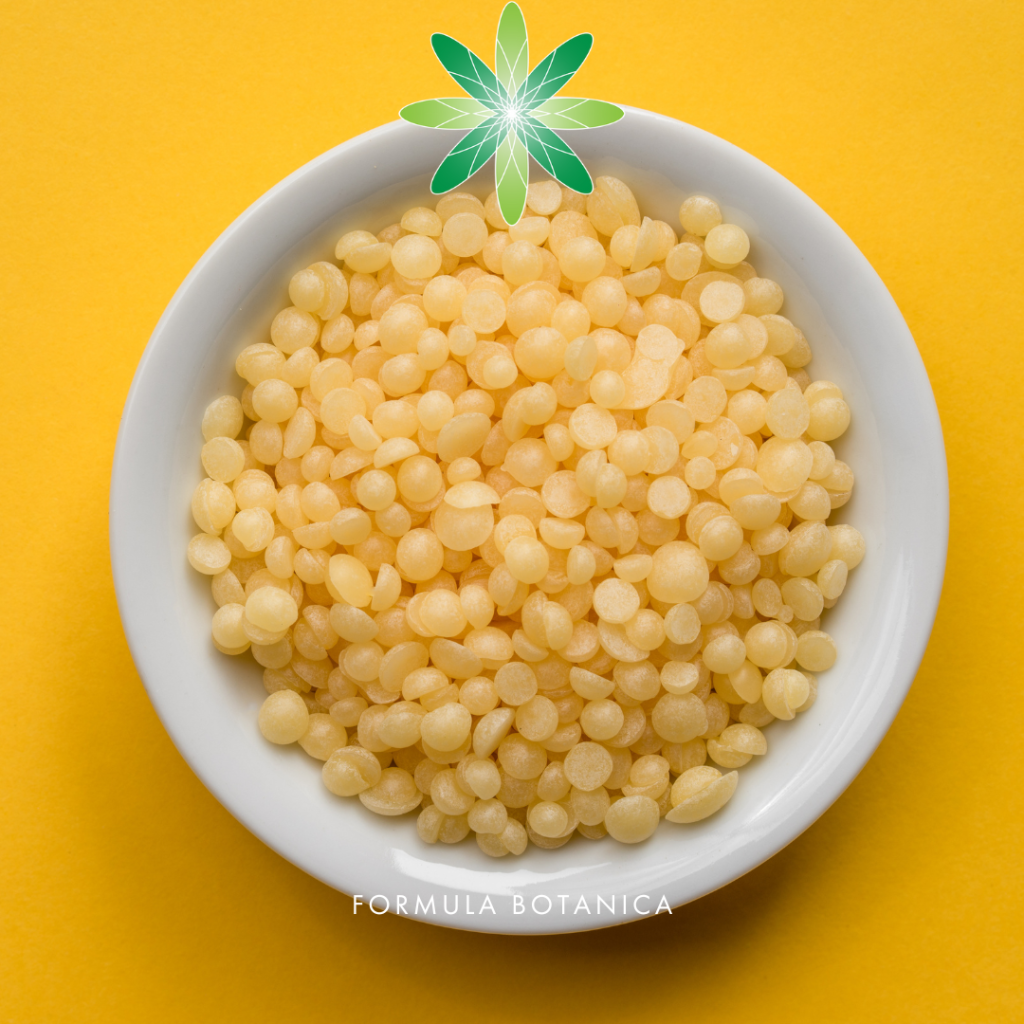
- INCI name: Helianthus annuus seed cera or Helianthus annuus seed wax
- Melting point: 74-85ºC
- Saponification value: 75-95 mg KOH/gr
- Acid value: 2-8 mg KOH/gr
Sunflower wax has a high oil binding capacity and a non-sticky skin feel. It imparts gloss to formulations and stabilizes water-in-oil emulsions. This wax contains approximately 30% hydrocarbons and 70% fatty esters. Behenyl acetate, lignoceryl acetate and methyl lignocerate are the primary wax esters.
Overview of Vegan Waxes
In this table, we’ve summarised the main features of each wax so that you can compare and contrast. Don’t be scared to experiment with new vegan waxes – one of the bestparts of being a cosmetic formulator is trialling new ingredients in your artisan lab!
| Common name | INCI name | Melting range
ºC |
Sap. Value
mg KOH/gr |
Acid value
mg KOH/gr |
| Candelilla wax | Euphorbia cerifera cera or Euphorbia cerifera wax | 68-73 | 43-65 | 12-22 |
| Carnauba wax | Copernicia cerifera cera or Copernicia cerifera wax | 80-86 | 78-95 | 2-15 |
| Rice bran wax | Oryza sativa cera or Oryza sativa bran cera or Oryza sativa bran wax | 79-85 | 65-95 | 2-15 |
| Berry wax | Rhus verniciflua peel cera or Rhus verniciflua peel wax | 48-54 | 180-220 | 5-30 |
| Myrica fruit wax | Myrica cerifera fruit wax | 45-55 | 210-240 | 5-25 |
| Sunflower wax | Helianthus annuus seed cera or Helianthus annuus seed wax | 74-80 | 75-95 | 2-8 |
How to formulate with Vegan Waxes
When it comes to choosing the right vegan waxes for your formulation, there are some aspects to consider.
Firstly, you should consider the hardness of the wax. The higher the melting point of a wax, the harder the finished product. If you’re making a stick formulation, you’ll need a wax with a high melting point. If you’re preparing formulations for a tropical climate, you’ll need a wax with a higher melting point. On the other hand, if you’re preparing a soft hand and body balm, you’ll need a wax with a low melting point. All waxes have their upsides and drawbacks. The choice depends on your product concept and can vary from product to product and from application to application.
When you replace a wax with another, the most important factor you’re looking for is the difference between melting points. Beeswax for example has a melting point of 61-65°C. If you’re going to replace beeswax with a wax with a melting range of 80-85°C, you’ll need lower concentrations of the wax. On the other hand, if you’re going to replace beeswax with a wax with a lower melting point wax then you’ll need higher concentrations of this substitute wax.
The balance between hardness (melting point), spreadability and skin feel should be adjusted by trial and error and according to the climate the product is going to be marketed in, the packaging and the product concept.
Bonus: Relaxing foot balm with rose clay
This is a rich foot balm with a very silky and non-greasy texture. Allantoin is an anti-inflammatory and moisturizing ingredient that, when blended with rose clay, pampers even the hardest and worst callus.
Ingredients:
| Phase A | |
| Myrica fruit wax (organic) | 10.0% |
| Cupuaçu butter (wildcrafted) | 10.0% |
| Shea butter (organic) | 30.0% |
| Phase B | |
| Organic perilla seed oil | 20.9% |
| Organic black seed oil | 15.0% |
| Lavender extract in organic baobab oil | 5.0% |
| Rose-infused organic jojoba oil | 5.0% |
| Tocopherol | 0.5% |
| Rosemary CO2 extract | 0.1% |
| Phase C | |
| Allantoin | 1.0% |
| Rose clay | 2.0% |
| Lavender essential oil (organic) | 0.5% |
Formulation method:
1. In a beaker, heat the myrica fruit wax, the cupuaçu butter and the shea butter in a water bath at 55-60°C. This is your phase A.
2. When the ingredients have melted completely, remove the beaker from the hot water bath and add the perilla seed oil, the black seed oil, the macerated lavender oil, the jojoba oil, the vitamin E, and the rosemary CO2 extract. This is your phase B. Stir the blend as it cools down. You can either cool down your preparation in an ice bath while stirring or put the beaker in the fridge and stir it every 10 minutes. Stirring during the cool-down process avoids graininess, which can be a challenge when making balms and butters (particularly when using shea butter).
3. As the blend reaches a trace (you can form a trace using a spatula during the cool-down phase), add the allantoin, rose clay and lavender essential oil to your mixture. This is phase C. Make sure you blend in all the powder.
4. Continue cooling down and stirring until the balm reaches a thick trace (almost half-solid). Now start whipping the blend with an electrical whisk. You may need to put the beaker in the fridge for short intervals in between whipping sessions. The colour of the balm will become milder and smoother while you whip.
5. When you reach the desired consistency, fill the balm in a suitable container and leave it in the fridge for 24 hours.
Now, it’s your turn!
We hope we have inspired you to try out lots of new vegan waxes. If you want to learn how to formulate vegan cosmetics, we teach an entire module on vegan cosmetic formulation in our Advanced Diploma in Organic Cosmetic Science.
Which vegan wax do you most want to try for your formulations? Leave us a comment below and let us know!
FREE TRAINING
Learn how to become an
Organic Skincare Formulator
FREE TRAINING
How to become an
Organic Skincare Entrepreneur
FREE TRAINING
How to become an
Organic Skincare Entrepreneur
Leave us a comment

Dr. Elham Eghbali was Formula Botanica’s Cosmetic Chemist between 2014 and 2018. She has over 20 years’ industry experience and is based in Bavaria, Germany. To read more about Formula Botanica’s team, visit our staff page.


